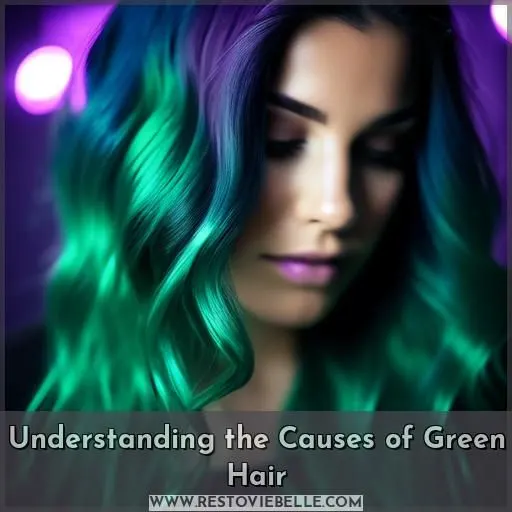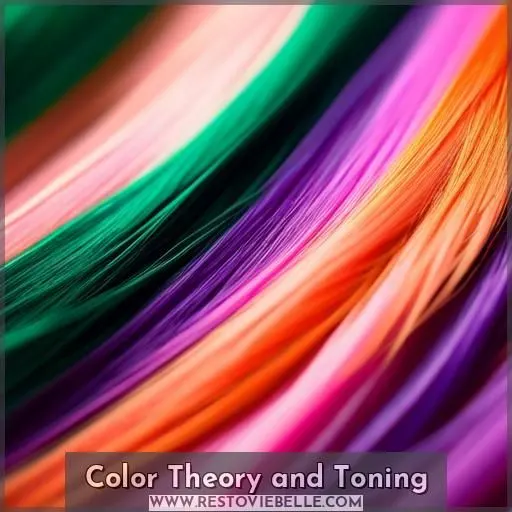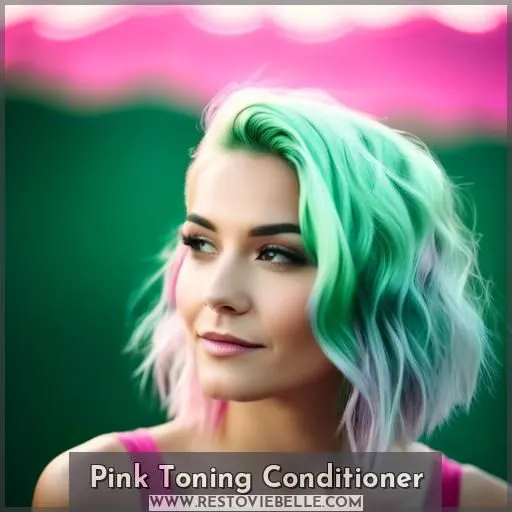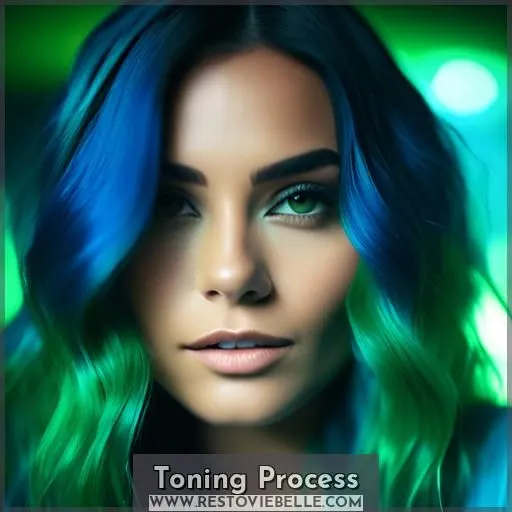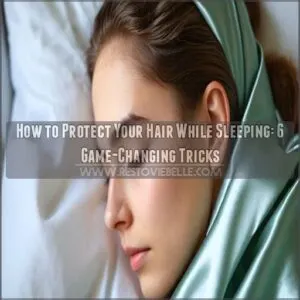This site is supported by our readers. We may earn a commission, at no cost to you, if you purchase through links.
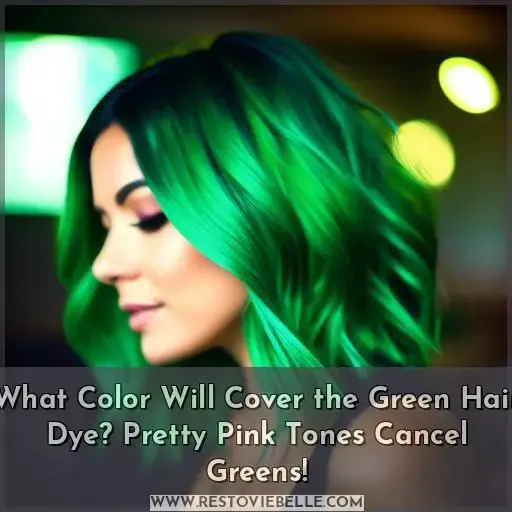
To cover green hair dye, you’ll want to use pink or red tones. These shades are directly opposite green on the color wheel, neutralizing unwanted green and teal tints.
A pink toning conditioner containing red-leaning pink pigments is ideal for removing greens while enhancing blonde and silver hues. Shampoo first, apply the toner evenly, wait 2-3 minutes, then rinse.
If you don’t have a toning conditioner handy, ketchup can provide a temporary fix using its red tones and acidity.
Want to learn the science behind cancelation tones and proper toning techniques?
Table Of Contents
Key Takeaways
- To counteract green hair dye, use pink or red tones, which are opposite green on the color wheel and can neutralize the unwanted color.
- A pink toning conditioner is an effective product for removing green and teal tints from hair, enhancing silver and blonde hues in the process.
- For a temporary fix in the absence of a toning conditioner, ketchup can be applied to the hair due to its red tones and acidity, which help diminish green shades.
- The toning process involves shampooing the hair, applying the pink toning conditioner evenly, waiting for 2-3 minutes, then rinsing and drying the hair.
What Color Will Cover the Green Hair Dye?
To cover the green hair dye, you can use a pink or red color.
Pink and red are on the opposite side of the color wheel and can help cancel out the green tones.
If the green is pale, a diluted pink dye may work.
For a more vivid green, a level 7 red or ginger color can be used.
If your hair is porous, adding warmer tones can help balance the unwanted green tones.
Understanding the Causes of Green Hair
Have you ever attempted to achieve a silver hair color, only to end up with an undesirable green tint? Chlorine exposure from swimming pools can also lead to unwanted green hues in your hair.
Botched Silver Attempts
Diving into silver hair dreams can sometimes land you in murky, green waters.
It’s all about the bleach baths, color removal, and understanding your hair’s porosity and texture.
Selecting the appropriate developer strength is essential.
But fear not, a pink toning conditioner is your lifeline.
Its pink and red tones, positioned opposite on the color wheel, expertly counteract those unwanted green tones.
Chlorine Exposure
Chlorine exposure can lead to green hair dye, as it can cause copper deposits, bleach damage, and mineral buildup.
To remove a green tint, try using a pink or red-leaning toning conditioner, which neutralizes green shades using opposite colors on the color wheel.
Apply the conditioner evenly and wait 2-3 minutes before rinsing and drying.
If ketchup is your only option, it can make a difference but won’t fully neutralize the green.
Color Theory and Toning
Ever wonder how to neutralize those pesky green tints left behind from that botched dye job or chlorine exposure? The secret lies in understanding color theory and using the opposite shade on the color wheel to cancel out the unwanted hue. In this case, you’ll want to reach for pink and red-based toners to counteract any lingering greens.
Neutralizing Shades Using Opposite Colors on the Color Wheel
To neutralize green hair, you can use pink dye.
Pink is the opposite color of green on the color wheel, so it cancels out the green tint.
This is based on the principle of color theory, which states that opposite colors on the color wheel neutralize each other.
By using pink dye, you can successfully neutralize the green color in your hair.
Pink and Red Tones Cancel Out Green
If you’re dealing with green hair, don’t despair! Pink and red tones can be your saviors. Here’s how:
- Understand the Color Wheel: Pink and red tones are on the opposite side of the color wheel compared to green. This means they can neutralize green hair.
- Use Pink Toning Conditioner: Pink toning conditioners contain red-leaning pink that can effectively remove green and teal tints from your hair. They can also enhance silver and blonde hues, giving your hair a fresh look.
- Follow the Toning Process: Before applying the conditioner, shampoo your hair. Apply the conditioner evenly, wait 2-3 minutes, then rinse and dry your hair.
- Repeat as Needed: Depending on the intensity of the green tint, you may need to repeat the process to achieve the desired result.
- Consider Alternatives: If pink toning conditioner isn’t available or you’re looking for a temporary solution, ketchup can also help neutralize green tints.
Pink Toning Conditioner
You’ve discovered that a pink toning conditioner is the perfect solution for neutralizing unwanted green and teal tints in your hair. These conditioners contain red-leaning pink pigments that effectively cancel out the green hues, while simultaneously enhancing your desired blonde or silver tones.
Contains Red-leaning Pink for Green and Teal Tints
Pink toning conditioner is your savior for eliminating green and teal tints.
According to color principles, pink and red tones neutralize green.
This conditioner, with its red-tinged pink shade, is ideal for this purpose.
It not only conceals the green but also eliminates the underlying pigments that cause it.
Therefore, don’t let your green hair dye deter you.
Unleash the potential of pink and dominate your hair color journey!
Removes Green and Teal Tints
Pink toning conditioner is a game-changer for those dealing with green or teal tints in their hair. Here’s why:
- Removes Green and Teal Tints: This conditioner is specifically formulated to neutralize unwanted green and teal shades, making it perfect for those who’ve had a botched silver attempt or experienced chlorine damage.
- Alternative to Ketchup Treatment: While ketchup can be a temporary solution, pink toning conditioner offers a more effective and long-lasting alternative.
- Pink Hair Trends: The popularity of pink hair has skyrocketed, making pink toning conditioner a must-have for those looking to jump on the trend.
- Safe Shampoos: Many pink toning conditioners are sulfate-free and gentle, making them a safe choice for those with sensitive scalps or color-treated hair.
- DIY Hair Treatments: Some pink toning conditioners can be used as a DIY hair treatment, allowing you to achieve salon-quality results at home.
- Keratin Treatments: If you’re considering a keratin treatment, using a pink toning conditioner beforehand can help guarantee the treatment adheres better to your hair.
Enhances Silver and Blonde Hues
Pink toning conditioners are your secret weapon against green hair dye.
These conditioners contain red-leaning pink tones that neutralize green and teal tints, making them perfect green neutralizers.
They also enhance silver and blonde hues, acting as silver enhancers and blonde highlights.
With regular use, these conditioners provide conditioning benefits that leave your hair looking and feeling great.
Incorporate them into your hair care routine for a quick and effective solution to green hair dye woes.
Toning Process
To begin the toning process, you’ll want to shampoo your hair thoroughly before applying the pink toning conditioner. Once your hair is clean, apply the conditioner evenly from root to ends, ensuring full coverage, and allow it to process for 2-3 minutes.
Shampoo Hair Before Applying Conditioner
After banishing those pesky green tints with a pink toning conditioner, you’re ready for the next step. Here’s how to set the stage for a flawless conditioner application:
- Start with a clean slate by shampooing your hair; this guarantees the toner adheres evenly.
- Pat your locks dry gently—think of it as priming your canvas.
- Now, you’re primed for the post-toning care that’ll bring out those enhancing highlights.
Apply Conditioner Evenly and Wait 2-3 Minutes
After shampooing your hair, evenly distribute the pink toning conditioner. Wait 2-3 minutes, allowing the conditioner to do its job. This wait time is essential for the best results. Remember, patience is key to getting the best color correction. Don’t rush the process, as it may affect the health of your hair.
Rinse and Dry Hair
After applying the pink conditioner, it’s time to rinse and dry your hair.
Rinse thoroughly to ensure all the conditioner is removed.
The application time may vary depending on your hair texture, so be patient and ensure it’s completely rinsed out.
If you’re worried about product availability, consider alternative methods like using ketchup as a temporary solution.
Once your hair is dry, assess the results and determine if additional steps are necessary for complete neutralization.
Availability and Alternative Solutions
You can purchase pink toning conditioners designed specifically to remove green and teal tints from hair. If you need a quick fix before getting a toning conditioner, an at-home treatment using ketchup can temporarily diminish green hues.
Pink Toning Conditioner is Available for Purchase
Pink Toning Conditioner: Neutralize Green with These Easy Steps!
- Pink Conditioner to the Rescue: Pink toning conditioner contains red-leaning pink that effectively neutralizes green and teal tints.
- Effortlessly Cancel Out Greens: By following the toning process, you can easily cancel out green hues, leaving your hair with a fresh, neutral look.
- Availability and Convenience: Pink toning conditioner is readily available for purchase, making it a convenient and accessible solution for those looking to neutralize green hair dye.
Ketchup Treatment Can Be Used as a Temporary Solution
Ketchup can be a temporary solution for neutralizing green hair.
It works by using the color wheel theory, where red is opposite to green.
The acidity of ketchup may also help in removing the green tint.
To use ketchup as a treatment, apply it evenly to your hair, especially focusing on the green areas, and leave it on for about 20-30 minutes before rinsing it out.
Repeat the process as needed until the green color fades.
Keep in mind that ketchup may leave your hair smelling like tomatoes, but this is a small price to pay for a temporary fix.
Conclusion
Ironically, the vivid green color you fought so hard to achieve is now the enemy.
Fear not.
Pretty pink tones are your allies in conquering those pesky green hues.
With a pink toning conditioner containing red-leaning pigments, you’ll effectively cancel out the green, restoring your locks to their desired shade.
Follow the toning process diligently, and a radiant, enviable hue that leaves green tints in the dust will cover the green hair dye.
